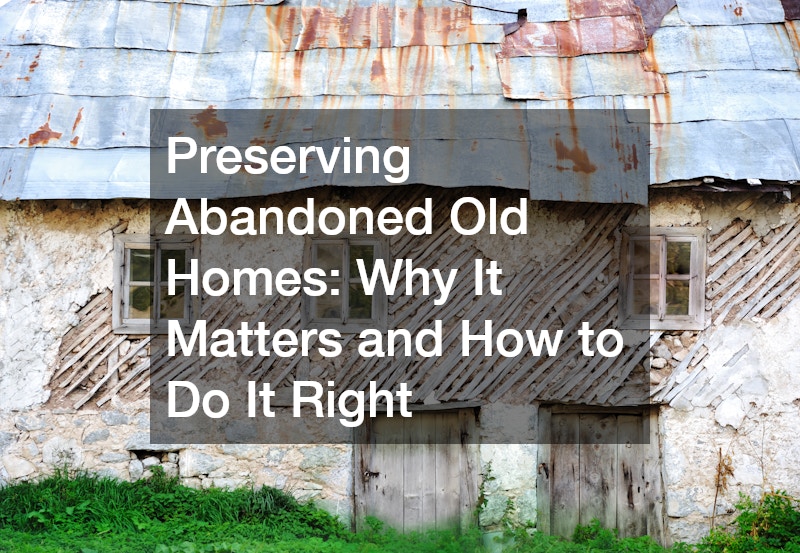Abandoned old homes stand as silent witnesses to the past, often overlooked, neglected, and dismissed as liabilities rather than assets. Yet, these architectural remnants carry layers of historical, cultural, and economic value that, when properly preserved, can rejuvenate entire communities. As cities evolve and modern buildings dominate skylines, the significance of saving these aging structures grows increasingly urgent. Preserving abandoned old homes is not merely about aesthetic appeal or nostalgia—it’s a multifaceted effort to maintain a tangible connection to our heritage, foster sustainable development, and cultivate community pride. This article explores why preserving these homes is essential, how to approach their restoration responsibly, and the wide-ranging benefits of doing so.
What are the historical values of abandoned old homes?

Architectural Significance
Abandoned old homes often showcase architectural designs that are rare or no longer practiced. From Queen Anne and Victorian to Colonial Revival and Craftsman styles, these homes highlight eras of craftsmanship and detail that modern construction frequently lacks. Their design elements—ornate cornices, original woodwork, stained glass, and hand-laid brickwork—represent the architectural philosophies of their time. Preserving these elements allows future generations to witness and study the artistry that shaped their communities. Working with architect design firms ensures that these details are preserved and integrated with modern updates in a way that respects the original design.
Cultural Heritage
These homes are more than physical structures—they are repositories of cultural memory. They reflect the lifestyles, beliefs, and social dynamics of the periods during which they were built. Whether once owned by prominent local figures or serving as boarding houses during industrial booms, abandoned homes can offer rich narratives about a community’s identity and evolution. Preserving them safeguards this intangible heritage from being erased, especially when curated by professionals experienced in cultural conservation and residential restoration.
Connection to Local History
Old homes often have stories deeply rooted in local history. They may be linked to early settlers, influential families, or significant community events. These personal and collective histories contribute to a neighborhood’s uniqueness. When these buildings are restored, they become living monuments, connecting current residents to their town’s lineage in a meaningful way. A local realtor can often uncover these histories through property records, adding another layer of depth to preservation efforts.
Artistic and Aesthetic Importance
Beyond structure and utility, abandoned old homes frequently hold intrinsic artistic value. Decorative flourishes like ceiling medallions, intricate moldings, or custom ironwork reflect a time when homebuilding was an expressive art form. These aesthetic elements enrich the visual landscape and elevate the cultural tone of a neighborhood, contributing to its charm and appeal. Restoration requires skilled labor, often sourced through specialized architect design firms and framing contracting professionals who understand the materials and methods from the home’s era.
Educational Opportunities
Preserved homes serve as open books for educators, historians, and students alike. They provide hands-on opportunities to study architectural styles, historical contexts, and even early construction techniques. Communities that invest in restoring these structures often repurpose them into museums or educational centers, creating engaging spaces that bring history to life.
Why are abandoned old homes at risk of demolition?
Urban Development Pressures
In many cities, land is more valuable than the structures upon it. Developers often view abandoned homes as obstacles to progress, preferring to raze them for new commercial or residential buildings. The push for new development can overshadow the value of historical preservation, especially when short-term gains are prioritized over long-term cultural enrichment.
Safety Concerns
Vacant structures are vulnerable to deterioration, which can lead to safety hazards like collapsing roofs, unstable flooring, or broken windows. Issues such as mold, water damage, and vermin infestation require immediate attention. Without proper pest control and window repair, these homes continue to decline, leading city officials to deem them unfit for rehabilitation.
Economic Factors
Restoring an abandoned home can be costly, especially if it requires structural overhauls or specialized craftsmanship. Many municipalities lack the funding or incentive to prioritize preservation, especially when the return on investment isn’t immediately apparent. For many homeowners or potential investors, the costs associated with hiring a building contractor, furnace replacement, or structural framing contracting services can be a deterrent.
Lack of Awareness
Many people are simply unaware of the value these homes hold. Without educational outreach or community engagement, residents may not understand why preservation matters. Informing the public about how these buildings can be restored and repurposed is a critical first step in preventing demolition.
Regulatory Challenges
Navigating zoning laws, building codes, and heritage regulations can be daunting. Restrictions may make restoration complicated or expensive, deterring investors from pursuing preservation. Clearer policies and incentives are needed to make the process more accessible and appealing.
How can communities benefit from preserving abandoned old homes?

Economic Revitalization
Restored homes often increase surrounding property values and attract new residents or businesses. This can spark a revitalization of neighborhoods, leading to broader economic development. Rehabilitated homes may also host small businesses, galleries, or community centers, contributing to local economies and job creation, including for trades like window repair and pest control.
Community Identity and Pride
Preserving historic homes reinforces a community’s identity and provides a sense of continuity. It fosters pride in shared heritage and contributes to a distinctive character that differentiates one neighborhood from another. These homes often serve as anchors for community events and historical celebrations.
Tourism Opportunities
Historical tourism is a growing industry, and preserved old homes can become valuable attractions. Guided tours, heritage trails, and seasonal events draw visitors, creating income for local businesses. A collaboration with a local realtor or tourism board can help package these offerings in a way that appeals to tourists and residents alike.
Social Cohesion
Restoration projects often unite communities around a shared goal. Volunteers, local nonprofits, and residents come together, strengthening social ties and promoting civic engagement. These collective efforts help create lasting connections among neighbors.
Educational and Cultural Programs
Restored homes can host workshops, art exhibits, lectures, and school programs. They become dynamic cultural centers that enrich the community. These programs are especially impactful when developed in partnership with educational institutions and heritage organizations.
What steps should be taken for the initial assessment of abandoned old homes?
Structural Integrity Evaluation
The first step in any restoration project is assessing the home’s structural integrity. A building contractor should inspect foundational elements, framing, roofing, and other critical components to determine what can be salvaged and what requires rebuilding.
Historical Research
Understanding a home’s past informs its future. Researching old maps, property records, and historical registries can reveal valuable information. Collaboration with local historians or historical societies often provides rich insights.
Environmental Considerations
Environmental assessments are necessary to identify issues like asbestos, lead paint, or mold. Additionally, tree overgrowth around the property may need the services of a tree removal company to prevent structural damage and clear restoration space safely.
Assessing Restoration Viability
Not every abandoned home can be saved, but many are more viable than they appear. An architect design firm can assess restoration feasibility by evaluating the building’s structure, style, and compatibility with modern standards.
Identifying Key Stakeholders
Successful restoration requires cooperation among many parties: homeowners, local governments, nonprofits, and private investors. Identifying and involving these stakeholders early in the process ensures smoother progress and access to resources.
How can funding be secured for preserving abandoned old homes?
Government Grants and Subsidies
Federal, state, and local governments often provide grants specifically for historic preservation. These programs may cover a portion of the restoration costs and help secure qualified building contractors or restoration specialists.
Heritage Conservation Funds
Various organizations allocate funds for preserving culturally significant sites. These funds typically support both large-scale renovations and smaller restorative projects, such as restoring a privacy fence or refurbishing original doors and windows.
Community Fundraising Efforts
Grassroots efforts—like donation drives, benefit events, and crowdfunding campaigns—can raise significant funds. These campaigns also raise awareness and foster community ownership of the project.
Private Investments and Partnerships
Developers and philanthropists may be interested in funding restoration projects, especially when aligned with their values or business models. Involving architect design firms and framing contracting experts early can present a professional, compelling case for investment.
Tax Incentives
Tax credits and abatements are powerful tools for encouraging restoration. They reduce the financial burden and make long-term investment more appealing to homeowners and developers alike.
What are the effective techniques for restoring abandoned old homes?
Structural Repairs
Addressing foundational damage, roof repairs, and wall stabilization are essential. A building contractor experienced in historic restoration can ensure that modern safety standards are met while preserving the home’s original design.
Restoring Architectural Features
Restoring moldings, staircases, doors, and decorative elements brings authenticity to the project. Many restoration professionals source period-appropriate materials to maintain historical accuracy.
Sustainable Practices
Eco-friendly materials and systems—such as solar panels, recycled wood, or high-efficiency furnaces—reduce long-term environmental impact. Propane tanks may be introduced as clean fuel alternatives in areas without access to natural gas.
Utilizing Modern Technologies
Tools like infrared imaging, structural scanning, and 3D modeling streamline the restoration process. They provide precise data that guides decisions and enhances preservation accuracy.
Compliance with Preservation Standards
Historic preservation guidelines vary by location but typically outline best practices for restoring older homes. Complying with these standards ensures the project receives appropriate recognition and support.
What are the legal considerations in preserving abandoned old homes?
Zoning Laws and Regulations
Zoning laws dictate how a property can be used or modified. Ensuring the home aligns with current zoning is crucial before beginning restoration work.
Property Rights and Ownership
Confirming legal ownership is a must. Some properties may be tied up in probate, foreclosure, or have unclear titles, delaying restoration efforts.
Heritage Preservation Laws
Certain homes may be protected under historic district regulations. These laws restrict certain changes and mandate approval from preservation boards before proceeding.
Liability and Safety Codes
Ensuring the property is safe for workers and future occupants requires compliance with safety codes. Installing or updating elements like a privacy fence may also be necessary for liability reasons.
Obtaining Necessary Permits
Permits are required for nearly every stage of restoration—from demolition to new construction to utility updates. Working with experienced framing contracting and building contractor teams helps streamline the permitting process.
How does preserving abandoned old homes impact environmental sustainability?
Reducing Urban Sprawl
Restoring old homes makes use of existing structures, reducing the need for new development and preserving green spaces on the urban fringe.
Energy Efficiency Improvements
Installing new insulation, efficient furnaces, and energy-saving windows significantly lowers a home’s carbon footprint. Proper window repair not only boosts energy efficiency but also preserves historic charm.
Recycling and Reusing Materials
Salvaging wood, bricks, fixtures, and other materials from the original home prevents waste and reduces the demand for new materials.
Green Spaces and Landscaping
Restored homes often include landscaping that promotes biodiversity and stormwater management. Removing unsafe trees with the help of a tree removal company may be necessary to make room for healthier ecosystems.
Promoting Sustainable Development
Preservation aligns with sustainability goals by extending the lifecycle of existing resources. This reduces the environmental toll of manufacturing and construction.
What challenges are faced in preserving abandoned old homes?

Financial Constraints
Restoration is often expensive. Despite grants and incentives, upfront costs can be a major barrier for many communities.
Political and Community Resistance
Not all residents or officials support preservation. Some view these efforts as costly or unnecessary, particularly in economically struggling areas.
Technological Limitations
While technology can aid restoration, the lack of access or expertise in certain communities can hinder progress.
Skilled Labor Availability
Historic preservation requires specialized skills that are in short supply. Craftspeople trained in traditional techniques are essential but not always available.
Time Constraints
Restoration takes time—sometimes years. Delays due to permitting, funding, or labor shortages can make projects less appealing to investors or residents.
How can technology aid in the preservation of abandoned old homes?

Digital Archiving
Digitally preserving records, photographs, and blueprints ensures that even if the physical structure cannot be saved, its history remains accessible.
3D Modeling and Virtual Tours
These technologies help visualize restoration potential, aiding both design planning and stakeholder engagement.
Simulation and Analysis Tools
Software can predict structural issues, energy usage, and environmental impact, allowing for informed restoration decisions.
Automating Restoration Processes
Tools such as automated cutting machines and drones can improve precision and reduce labor costs, especially for difficult-to-access areas.
Digital Community Engagement
Web platforms and social media campaigns can rally support, raise funds, and involve more people in the restoration process.
Final Thoughts
Preserving abandoned old homes is far more than a sentimental endeavor—it’s a practical, cultural, and sustainable investment in our collective future. By understanding their historical value, tackling legal and structural challenges, and leveraging modern technologies, communities can breathe new life into these architectural treasures. The involvement of architectural design firms, local realtors, skilled building contractors, and civic groups can transform neglected properties into cornerstones of revitalized neighborhoods. Whether through restoring a classic furnace, replacing windows, or building a privacy fence to secure the grounds, every step taken contributes to a more vibrant, cohesive, and historically rich community.


